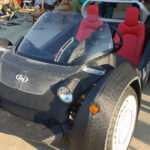The Mustang Shelby GT500 goes on sale later this year, offering the latest frills automotive engineering has to offer. This high performance vehicle is another notch in the long line of renowned Mustangs under Ford’s design ingenuity. This time around the preliminary testing and simulations brought in very high levels of virtual testing using supercomputers and 3D printing, giving it the extra edge in early phases. The impact of these new means of testing has had tangible effects on several aspects of the GT500’s design.
The Shelby GT500 is shaping up to be the fastest accelerating and aerodynamically advanced street-legal Mustang to date. Performance designers, powertrain and aerodynamics engineers set up virtual racing teams to test hundreds of designs in digital and physical form. It allows designer to gain an in-depth level of knowledge before rubber even hits the road.
“We created and studied designs among the engineering teams and proved out different strategies long before we built our first prototype cars,” said Matt Titus, Ford Performance vehicle engineer. “Not only did this improve the effectiveness of the designs, it dramatically reduced the time it took to develop the GT500 – and the costs associated with that.”
Mustang Prototyping & Testing
Ford’s testing and validation teams ran through a whole lot of data, using over five hundred 3D cooling and aerodynamic designs. Prominent simulations ran for cooling systems, front fascia and splitter designs, brake ducting, rear spoiler designs and the large 6.03 square ft (0.56 square m) hood vent. They analyzed each of these to boost aerodynamic performance and cooling. Then, they took the advanced design models further, using chassis simulators at Ford’s technical center with the aid of professional drivers.
They 3D printed the most promising designs in a matter of days, which sped up the improvement stages immensely. This pace allowed them to tweak the Shelby GT500 little by little, bringing in new physical designs rapidly. By the end, they were able to refine it to a maximum rear downforce of 550 lb at 180mph (290km/h). They also developed a new spoiler-wing hybrid design that the team are calling ‘the swing’. This new design is a prominent factor in the GT500’s impressive aerodynamic capabilities.
The Shelby GT500 teams made use of the Ford Performance Technical Center in Concord, North Carolina, and rapid 3D prototyping systems at its Advanced Manufacturing Center and wind tunnels in Redford, Michigan. They also ran simulations and tests to ensure the fastest run-times (for a Mustang) on world-famous racetracks. Overall, the new prototyping, simulation and testing technologies are taking an already advanced industry even further. Though they’ve used the technology before, Ford aren’t the only ones leveraging 3D printed design possibilities.
Featured image courtesy of Ford, retrieved via Automotive Live Testing Technology International website.













